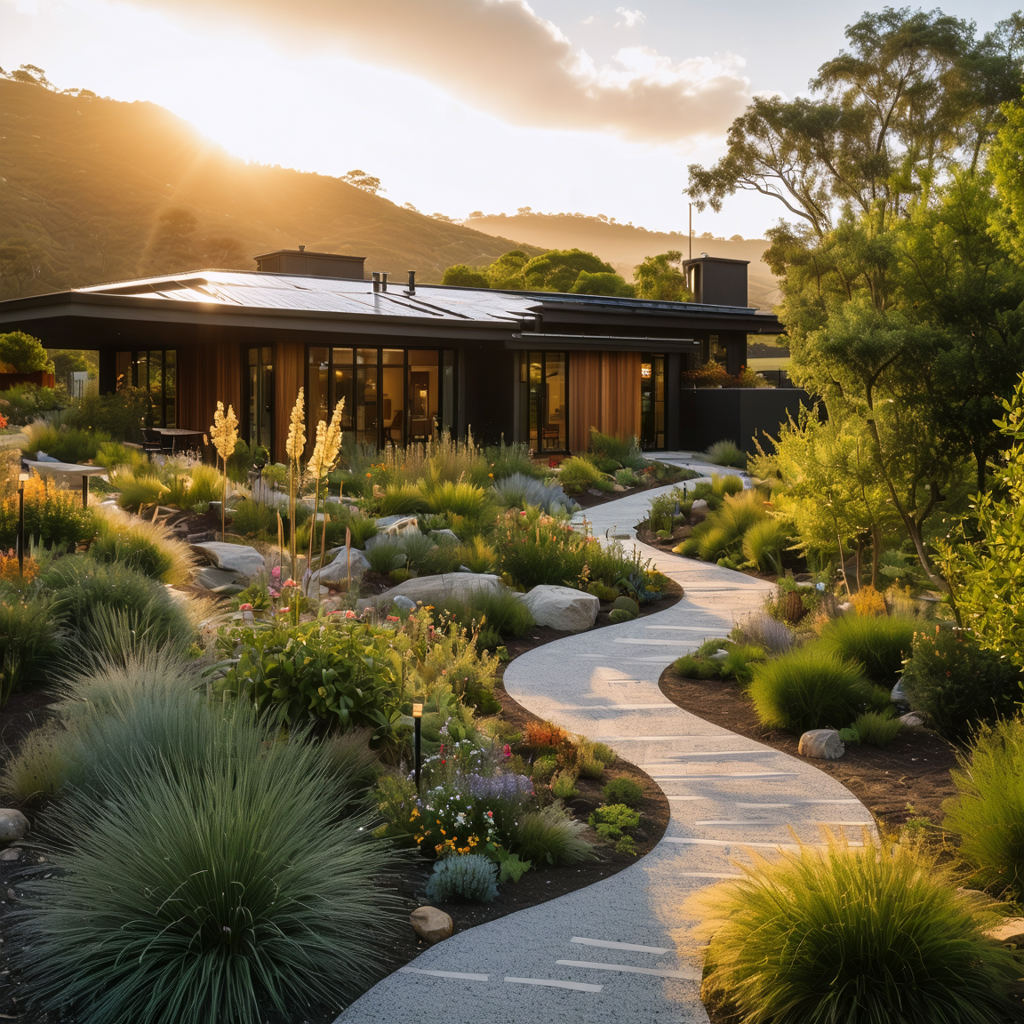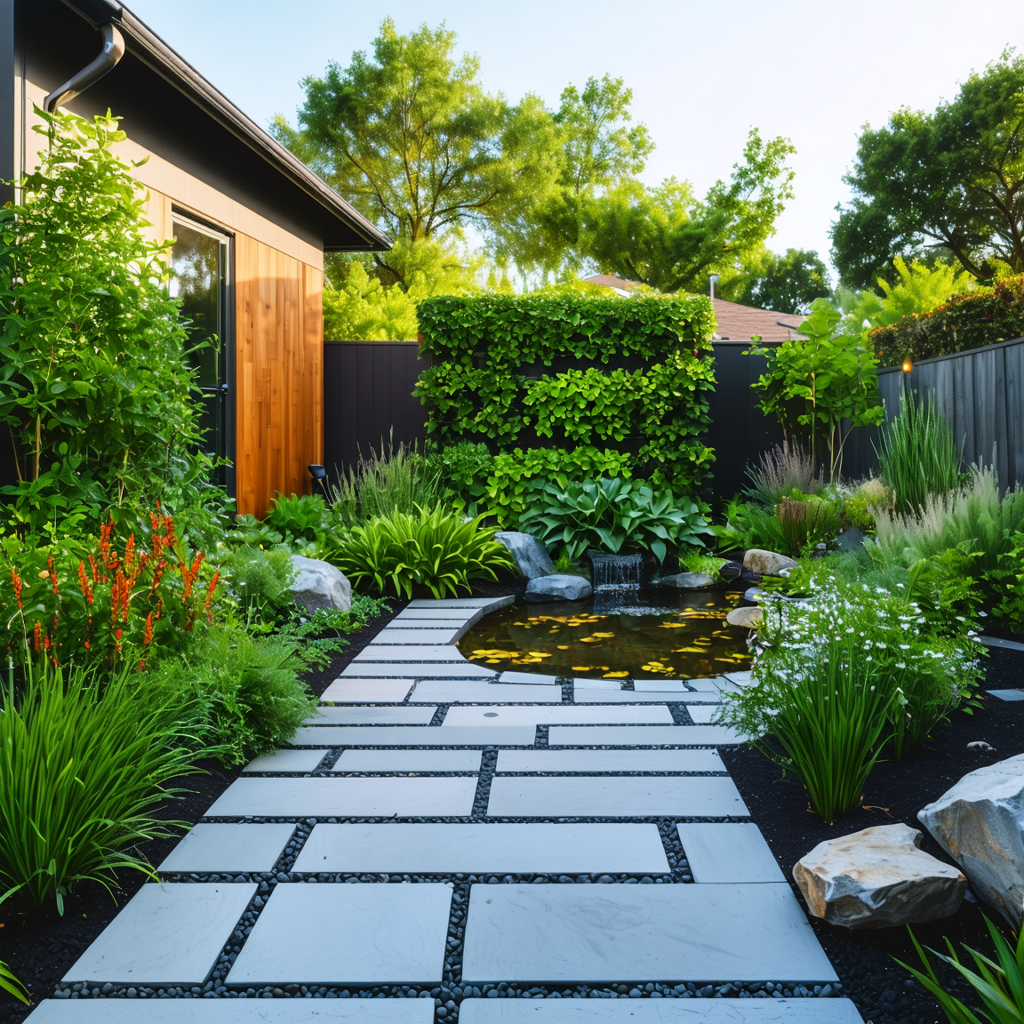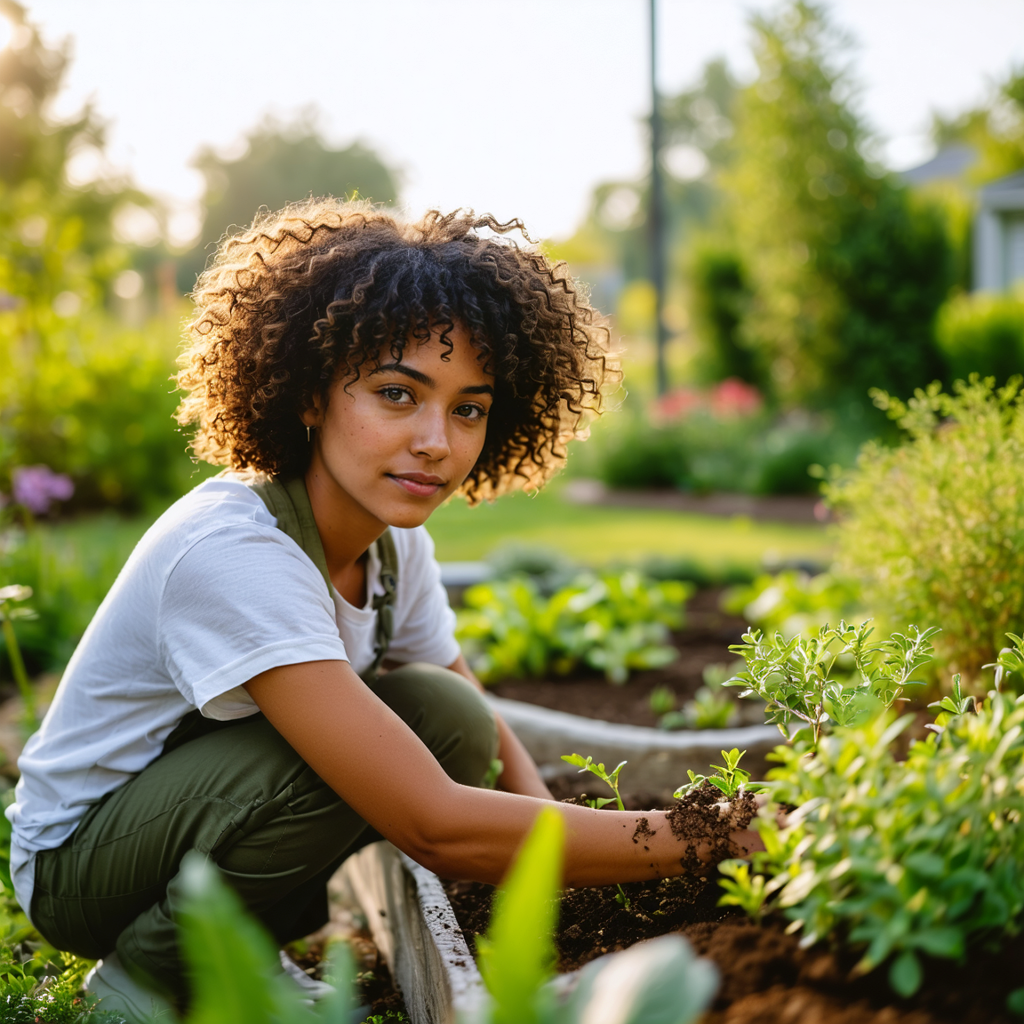Introduction to Sustainable Landscape Design
Ever wondered how to make your little patch of the Earth more environmentally-friendly?
If so, then let’s talk about sustainable landscape design.
As the name suggests, it’s a method where your surroundings are improved without negatively impacting the environment. Whether you live in a sprawling country estate or a cozy urban apartment, you can implement sustainable landscape designs.
Throughout this blog post, we’ll explore what sustainable landscape design includes, its core principles, and how it conserves water, promotes soil health, and reduces waste. We’ll show how sustainability meets aesthetics, helping you reduce your carbon footprint without compromising on the beauty of your surroundings.
Ready for a green transformation?
Table of Contents
What is the Definition of Sustainable Landscape Design?
Core Principles of Sustainable Landscape Design
Sustainable landscape design balances the use of environmental resources with the creation of areas that are functional, aesthetically pleasing, and ecologically harmonious.
Its primary goals are to conserve water, reduce waste, and protect natural habitats.
Water Conservation Techniques
Efficient water use is a fundamental aspect of sustainable landscape design. Here are some techniques:
- Xeriscaping: This involves using drought-resistant plants that require minimal water.
- Rain Gardens: These gardens collect and absorb rainwater, reducing runoff and providing natural irrigation.
- Drip Irrigation: This method delivers water directly to plant roots, minimizing water waste.
Soil Health and Plant Selection
Healthy soil is essential for plant growth and sustainability. Key practices include:
- Composting: Adding organic material to soil enhances its nutrient content and structure.
- Mulching: Covering soil with mulch helps retain moisture and suppress weeds.
- Native Plants: Choosing plants that are native to the area can thrive with minimal maintenance and resources.
Energy Efficiency in Landscaping
Sustainable landscapes can also reduce energy use by incorporating:
- Shade Trees: Strategically planted trees can reduce cooling costs by providing shade to buildings.
- Windbreaks: Planting trees or shrubs as wind barriers can reduce heating costs by preventing wind from hitting buildings directly.
- Solar Lighting: Utilizing solar-powered lights minimizes electricity use.
Biodiversity and Wildlife Habitat
Promoting biodiversity is a key component of sustainable landscape design. This includes:
- Creating Habitats: Design spaces that provide food, water, and shelter for local wildlife.
- Pollinator Gardens: Planting flowers that attract bees, butterflies, and other pollinators.
- Reducing Chemical Use: Minimize the use of pesticides and herbicides to protect beneficial insects and animals.
Material Selection and Waste Reduction
Choosing sustainable materials and reducing waste can significantly impact the environment. Consider:
- Recycled Materials: Use recycled or reclaimed materials for hardscaping elements like pathways and benches.
- Local Sourcing: Purchase materials locally to reduce transportation emissions and support local businesses.
- Composting Yard Waste: Turn grass clippings, leaves, and other yard waste into compost instead of discarding them.
Sustainable Landscape Design Examples
Sustainable landscape design can be seen in various settings. Examples include:
- Residential Gardens: Incorporating native plants and efficient irrigation systems in home gardens.
- Public Parks: Designing parks with native vegetation, green roofs, and sustainable water management systems.
- Commercial Spaces: Employing green walls and rainwater harvesting systems in commercial landscapes.
For more in-depth information on sustainable landscape practices, you can explore detailed guidelines on EPA’s official website.
The Concept of Sustainable Landscape Design

The Harmonious Integration of the Built and Natural Environment
The crux of sustainable landscape design is the seamless synergy between human-made constructions and the environment. It aims to create a complementing interaction between both elements that benefits not only the built structures but, more importantly, preserves and enhances the natural landscape. An integral part of this endeavor is the extensive use of permeable paving materials that reduce rainwater run-off and allow precious water to refill the aquifers beneath.
Sustainable Landscape Maintenance
Another pivotal aspect of sustainable landscape design lies in the maintenance phase. Traditional landscape methods often require non-renewable resources that are harmful to the environment and expensive. Sustainable practices encourage organic maintenance, which involves using natural products to fertilize the soil and control pests. It not only enhances the health of the environment but also reduces costs in the long run.
Promoting Local Economies
In addition to supporting the environment, sustainable landscape design also fosters the local economy. From sourcing materials and plants to hiring local artisans and workers, the employment opportunities created by sustainable practices strengthen the local economy and build a sense of community.
Benefits of Sustainable Landscape Design

Enhanced Human Well-being
Studies have shown that interaction with nature improves human well-being. These landscapes are designed not only to benefit the environment but also to enhance the quality of life. For instance, a properly designed landscape can lower heart rate, decrease stress levels, and improve overall mental health.
Curb Appeal and Property Value
An aesthetically pleasing outdoor environment can significantly increase property value. If implemented correctly, sustainable landscapes are not only appealing to the eye but also give the added benefit of potentially increasing the property’s market value.
Resource Efficiency
Sustainable landscape designs prioritize efficiency in terms of resource utilization. From irrigation systems and energy usage to pest management, these landscape designs reduce costs and lead to significant financial savings in the long run.
Climate Adaptation
Sustainable landscapes are designed to be resilient to climatic variability. These designs factor in climate change effects and incorporate mechanisms to cope with potential future conditions, thereby playing an essential role in our adaptation strategies.
Preserving Biodiversity
By incorporating native species and promoting biodiversity, sustainable landscapes can serve as small-scale reserves for local fauna and flora. These spaces can become sanctuaries for pollinators and birds, thus contributing to the overall biodiversity network.
To learn more about sustainable landscape design’s benefits to both the environment and human wellbeing, check out the resources provided by the UCLA’s Sustainability guide for greening your environment.
Innovative Ideas for Sustainable Landscape Design
Green Roofs and Walls
Green roofs and walls offer an innovative way to maximize urban green space. They provide insulation, reduce surface runoff, and create habitats for wildlife. Additionally, they improve air quality and decrease the urban heat island effect.
Sustainable Urban Drainage Systems (SUDS)
SUDS are designed to manage stormwater sustainably. Incorporating features like swales, permeable pavements, and green roofs, SUDS aim to mimic natural drainage processes to reduce flooding and water pollution.
Edible Landscaping
Edible landscaping blends ornamental gardening with food production. Utilizing fruit trees, vegetables, herbs, and nut trees, these designs offer both ecological and nutritional benefits.
Rainwater Harvesting Systems
Installing rainwater harvesting systems can significantly reduce the demand on municipal water supplies. These systems collect and store rainwater for irrigation and other non-potable uses.
Sustainable Landscaping Technologies
Smart Irrigation Systems
Modern technology allows for smart irrigation systems that tailor water usage based on weather conditions, soil moisture, and plant needs. These systems reduce water waste and promote efficient water use.
LED Lighting
LED lighting is energy-efficient and lasts longer than traditional bulbs. Using LED lights in landscape design reduces energy consumption while providing adequate illumination for safety and aesthetics.
Solar-Powered Pumps
Solar-powered water pumps for fountains and irrigation systems can reduce electricity usage. These pumps harness renewable solar energy, making them an eco-friendly alternative.
Geothermal Heating and Cooling
Geothermal systems use the earth’s natural temperature for heating and cooling, which can be integrated into under-soil heating for lawns and gardens. This sustainable energy source reduces dependency on fossil fuels.
Innovative Planting Strategies

Companion Planting
Companion planting involves growing different types of plants together that mutually benefit each other. For example, planting marigolds with vegetables can deter pests naturally without chemical intervention.
Vertical Gardens
Vertical gardens maximize limited space, particularly in urban settings. They involve growing plants on vertically suspended panels, which can be used both for functional and aesthetic purposes.
Hydroponics and Aquaponics
Hydroponics and aquaponics grow plants in a water-based, nutrient-rich solution, with or without the use of soil. These innovative methods conserve water and can be ideal for urban settings where traditional gardening space is limited.
Educational and Community Integration
Community Gardens
Community gardens not only provide fresh produce but also create a sense of community and promote sustainable living practices. They act as educational platforms for teaching people about sustainable agriculture and healthy eating.
Outdoor Classrooms and Labs
Integrating outdoor classrooms and laboratories in educational institutions fosters hands-on learning about ecology, sustainability, and conservation. These spaces help students and the community to engage with and learn about their local environment.
Public Workshops and Training
Organizing public workshops and training sessions on sustainable landscape design can empower communities to implement these practices in their own spaces. These events can cover topics ranging from composting to smart irrigation.
For more insights on how sustainable practices can revolutionize your landscape, explore the Planet Natural Research Center’s resources on eco-friendly gardening.
Where are Areas for Improvement in Sustainable Landscape Designs?
Advanced Water Management Solutions
Water management is essential, but many landscapes can benefit from integrating more sophisticated technologies. Current techniques like xeriscaping, rain gardens, and drip irrigation are great, but there’s room for improvement through:
- Graywater Systems: Recycling household water (from baths, sinks, etc.) for irrigation purposes.
- Rainwater Harvesting Automation: Automated systems that not only collect but also distribute rainwater efficiently.
- Water-Sensitive Urban Design (WSUD): Integrating the urban water cycle into landscape planning to responsibly manage stormwater.
Enhanced Soil Health through Innovative Practices
While composting, mulching, and selecting native plants are effective, landscapes can further improve soil health by:
- Biochar: Adding biochar to soil improves fertility, increases water retention, and sequesters carbon.
- Mycorrhizal Fungi: Utilizing fungi that form symbiotic relationships with plant roots, enhancing nutrient uptake.
- Cover Cropping: Growing specific crops to cover the soil, reduce erosion, improve soil structure, and boost organic matter.
Improving Energy Efficiency Beyond Basics
Energy efficiency from shade trees, windbreaks, and solar lighting can be expanded with:
- Passive Solar Design: Designing landscapes to make the most of natural sunlight for warmth and light.
- Renewable Energy Installations: Including small wind turbines or advanced solar panels within the landscape.
- Green Roofing Systems: Integrating extensive green roofing systems for better insulation and energy efficiency.
Boosting Biodiversity and Habitat Creation
Creating habitats and pollinator gardens are essential, but biodiversity can be enriched by:
- Planting Diverse Species: Using a variety of plants that bloom at different times to support a more stable and diverse ecosystem.
- Incorporating Wetlands: Creating small wetlands or ponds to support aquatic plants and creatures, promoting a broader range of biodiversity.
- Building Wildlife Corridors: Establishing connected wildlife passages to aid the movement and migration of species through urban or residential settings.
Optimizing Material Selection and Reducing Waste Further
In addition to using recycled materials and local sourcing, landscapes can improve by:
- Cradle-to-Cradle Certified Products: Selecting materials that can return to the biosphere safely or be reused with minimal waste.
- Deconstruction and Reuse: Breaking down old structures carefully so materials can be reused in new projects.
- Advanced Composting Methods: Techniques like vermicomposting using worms to break down organic waste more efficiently.
Using Innovative Ideas for Future Sustainability
While existing techniques like green roofs, edible landscapes, and rainwater harvesting are excellent, innovation could push further with:
- Multifunctional Landscapes: Designing spaces that serve multiple purposes, such as combining recreational areas with stormwater management systems.
- Nature-based Solutions: Employing natural processes to address environmental challenges, such as using plants to filter stormwater naturally.
- Technological Integration: Incorporating sensor networks for real-time monitoring of soil moisture, weather conditions, and plant health, enabling more responsive and adaptive management.
Technological Advancements in Landscaping
While smart irrigation, LED lighting, and solar pumps are gains, more can be achieved by:
- GIS-Based Planning: Using Geographic Information Systems (GIS) to plan optimal plant placement, water management, and habitat construction.
- Automated Maintenance Robots: Employing robots for tasks like mowing, weeding, and monitoring plant health to reduce labor and improve precision.
- Blockchain for Supply Chain Transparency: Using blockchain technology to ensure the provenance and sustainability of materials used in landscaping projects.
Conclusion: Towards Sustainable Landscaping for the Future
As we grapple with the realities of a changing climate, the concept of sustainable landscape design has never been more pressing.
With its goal of marrying functionality and aesthetics while conserving environmental resources, sustainable landscaping is our pathway to creating outdoor spaces that breathe life, rather than take it away.
Through effective water conservation techniques, improving soil health, ensuring energy efficiency, promoting biodiversity, smart material selection, and reducing waste, we can create varied spaces, from residential gardens to commercial landscapes, that not only exist in harmony with nature but give back to it.
As an evolving practice, sustainable landscape designs constantly seek to improve and innovate. The integration of advanced technologies, more comprehensive maintenance practices, and a stronger emphasis on community involvement are among the areas ripe for future exploration.
Over time, our landscapes can become not just sustainable, but regenerative—spaces that restore, renew, and revitalize their own sources of energy and materials.
By adopting sustainable landscape design principles, we can each play a role in creating an environmentally sensitive and sustainable future.
Frequently Asked Questions – FAQs
What is sustainable landscape design?
Sustainable landscape design is an approach that combines aesthetic appeal with environmental respect. It involves the use of techniques and materials that conserve water, improve soil health, boost biodiversity, reduce waste, and enhance energy efficiency.
What are some examples of sustainable landscape design techniques?
Techniques include xeriscaping (using drought-tolerant plants), rainwater harvesting, composting, the use of renewable energy sources, promoting biodiversity through the use of native plants, and implementing recycled and locally-sourced materials.
Why is sustainable landscape design important?
Beyond creating beautiful outdoor spaces, sustainable landscape design helps conserve natural resources, reduces waste, protects natural habitats, and helps mitigate the effects of climate change. It contributes towards environmental preservation and enhances the quality of human life.
How can sustainable landscape design be improved?
Improvements can be made through advanced water management solutions, innovative practices to enhance soil health, improving energy efficiency, boosting biodiversity, optimizing material selection, and reducing waste. Technological advancements can also contribute significantly to the enhancement of sustainable landscaping.






